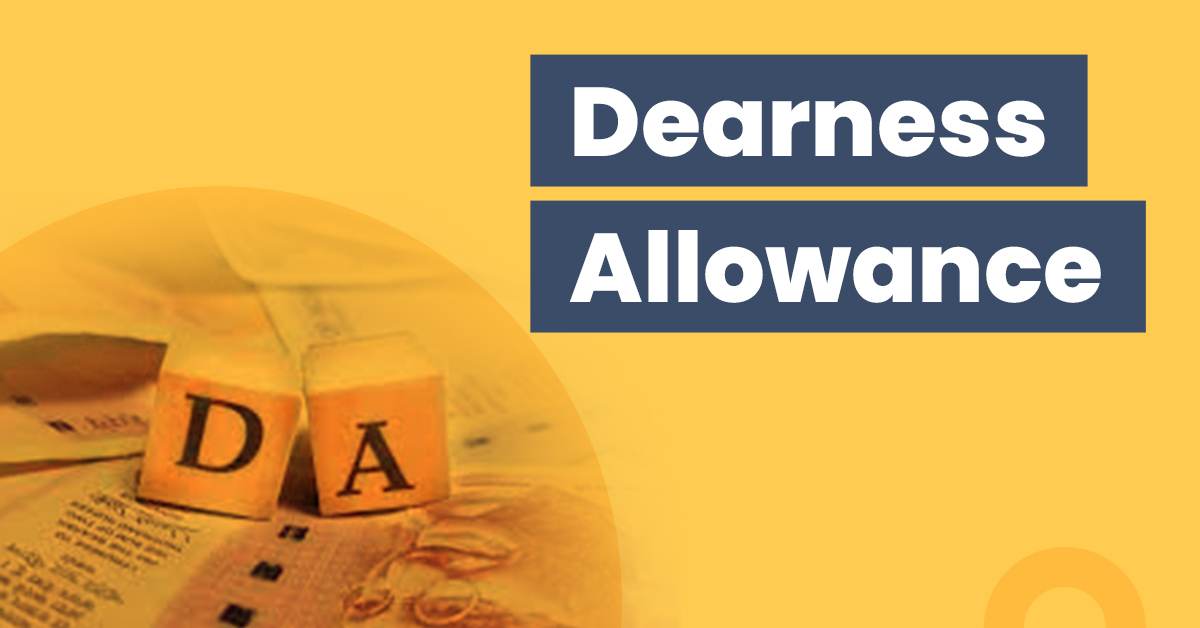Dearness Allowance (DA) – Meaning, Types, DA Calculation & Taxability


Every employee has a basic salary consisting of different allowances. These allowances are mandatory in both the public and private sectors. Employers can choose which allowances they can give their employees as per the rules and company policies. One such allowance is the DA or dearness allowance.
What Is Dearness Allowance?
Dearness Allowance (DA) is the amount paid by the government to public sector employees to cope with the rising inflation graph. DA applies not only to working employees but also to pensioners. Dearness allowance is calculated based on a fixed percentage of the basic salary. In addition, DA forms a substantial part of the salary of Central Government employees.
Further, DA is decided as per the employee’s location as it is directly proportional to an employee’s living cost. Thus, DA is affected depending on whether it is an urban, rural or city area.
Earlier DA was based on the demand for wage revisions. Later, DA was considered on the basis of the Consumer Price Index exclusively for meeting the enhanced cost of living. However, as the cost of living keeps fluctuating, hence, an increment in dearness allowance is also necessary. This is a practical step taken by the government to save its employees from the negative impact of inflation.
What Are the Types of DA?
Let’s consider that DA is of 2 types for ease of calculation. These are as follows:
- Industrial Dearness Allowance
The Central Government gives Industrial Dearness Allowance or IDA based on quarterly revision. Hence, the Consumer Price Index has a link with this quarterly revision. The Central Government has increased IDA by 5% for public sectors. IDA benefits all types of Central Government employees, executives, and officers.
- Variable Dearness Allowance
Variable Dearness Allowance, commonly known as VDA, is a type of DA that is revised every 6 months. This amount also depends on the inflation of CPI and the increased cost of living. There are 3 components VDA depends on, these are;
- Base Index: This is a fixed amount for a specific period.
- Consumer Price Index: It is the most impactful on VDA, and it constantly fluctuates.
- The Variable DA Amount Fixed by the Government of India: This is also a fixed amount unless the government revises basic minimum wages.
Also Read: Best International Mutual Funds in India to Invest in 2023
How to Calculate Dearness Allowance?
Dearness allowance is similar to other allowances such as HRA or medical allowance and is calculated in the basic salary. However, DA gets increased twice a year to meet the impact of rising prices. The calculation of DA is as follows:
- For Central Government Employees
DA% = [{Average of All-India Consumer Price Index (Base Year- 2001 = 100) for the last 12 months – 115.76}/115.76] x 100
- For Public Sector Employees
DA% = [{Average of All-India Consumer Price Index (Base Year- 2001 = 100) for the last 3 months – 126.33}/126.33] x 100
Dearness Allowance for Pensioners
Pensioners are retired employees who receive either an individual or family pension from the government. Every time the central government revises the salary structure, it reflects on the amount of DA that a pension holder gets. However, if pensioners become re-employed, DA will not be applicable if DA is granted on a time scale or on a fixed pay.
Taxability of Dearness Allowance
DA is completely taxable as per the latest revision of the year 2017-18. For example, if a salaried individual gets any unfurnished rent-free accommodation from the employer, DA will become a part of the retirement benefit salary of that employee by adhering to all prerequisites. Besides, individuals should declare the tax liability of DA while filing an ITR.
Also Read: Special Allowance in India: What Is It, Taxation & Calculation?
What Is the Current Dearness Allowance Rate?
As the DA rate depends on different components, such as the location of the employee and CPI, it changes constantly. However, as per the hike in July 2022, the current rate of dearness allowance for central government employees is 38%.
What Is the Role of Pay Commissions in DA Calculation?
The role of pay commissions is to revise and assess the salaries of public sector employees. Thus, it examines every component of salary and prepares the final salary for the employee. Further, it also checks every factor that influences salary. Thus, the pay commission checks the dearness allowance while making an accurate pay commission report.
Differences Between DA and HRA
DA and HRA are two completely different components and have different taxability. The differences between these two are as follows:
| DA | HRA |
| Tax exemptions or deduction does not apply to DA | HRA has some tax deductions applied to it. |
| DA is only for public sector employees. | HRA is available for both public and private sector employees. |
| DA is for meeting the increased cost of living. | HRA is the amount to compensate for the expenses of an employee’s rented accommodation. |
| DA is calculated as a percentage of an employee’s basic salary | HRA is not calculated as a percentage of the basic salary of an employee. |
Dearness Allowance Merger
Central government employees get DA to cope up with the adverse effects of inflation. The changes in DA have an effect on the salary calculation. As per practice, when the hike in the dearness allowance of an employee reaches 50%, DA is to be merged with the basic salary. Thus, it will increase the salary amount as well. This demand for DA merger has already been raised to the government and awaits approval.
Final Word
Dearness allowance is one of the major components of the basic salary of government employees. Its calculation and increment influences the entire salary structure. Besides, it is devised by the government to help employees meet daily requirements during inflation.
This article has covered all the necessary information regarding DA for your reference. Therefore, consider this guide to learn about meaning, types and other necessary details related to DA.
Frequently Asked Questions
When do pensioners not get a DA?
Central government pension holders are eligible to get a dearness allowance. However, under the following circumstances, they won’t get a DA:
a) If a pension holder starts a new job.
b) If a pension holder gets a new job abroad.
However, there are some exceptions too. For example, DA will be applicable if a pensioner stays abroad without employment. Further, pensioners with a new job may get DA, but it will be limited to their last drawn pay.
How to calculate dearness allowance on a pension?
Similar to regular employees, dearness allowance for pensioners is calculated on the basis of basic pension excluding commutation. Therefore, pensioners get DA as a percentage of their original pension. The current DA rate is applicable here.
Is DA and special allowance the same?
No, DA is not the same as a special allowance. DA is only for government employees; however, special allowance is for both public and private sector employees. DA is compensation for inflation, and a special allowance consists of different kinds of allowances, such as conveyance, travel, medical, etc. There is no deduction or exemption in DA; however, a special allowance has exemptions.



